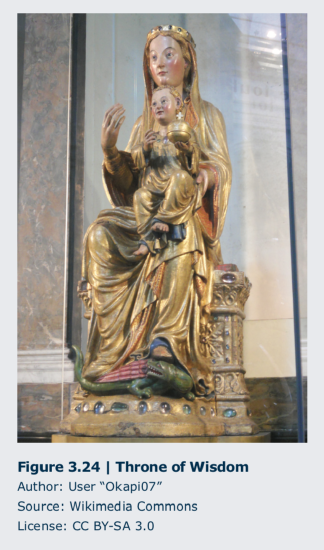3.5: Wood, Inlay, and Lacquer
- Page ID
- 10126
Sculptures, objects, and architectural components of wood were also fashioned with a view to their monetary and cultural value. Some varieties of wood are more rare, others have qualities that make them easier to work in certain types of process, and there have been waves of “fashion” in wood choices at many eras. For example, lindenwood and limewood are associated with the Middle Ages, mahogany with eighteenth-century England and Scotland, oak with the Arts and Crafts work of the mid-nineteenth to early twentieth centuries, and delicately lacquered wooden goods with Yuan Dynasty China.
Wooden sculpture was a far more predominant art form than painting in northern Europe during the Romanesque (c. 1000-1200) and Gothic periods (c. 1200-1500) in that region. The material favored was lindenwood or limewood due to the fineness of the wood’s grain, which allowed the sculptor to carve intricate detail. Generally, the sculpture was then poly- chromed, or painted, to increase the lifelike quality of the figure. Suggesting that spark of life was important in works such as The Throne of Wisdom because Mary, the compassionate and merciful Mother of God and Queen of Heaven, was believed to have the power to intercede with her Son, the infant Christ, on behalf of the faithful. (Figure 3.24)

 Mahogany was discovered as a marketable wood by European explorers and traders in the Caribbean islands, Central America, and South America by the seventeenth century. The naturally reddish-brown wood was prized for its beauty and strength and, throughout the 1700s, was frequently used in England and Scotland to create fine furniture for the market there and in the American colonies. A table such as this was a status symbol indicating the own- er’s wealth and taste, which was further enhanced by its use: this was not a utilitarian piece but a display table for chinaware. (Figure 3.25)
Mahogany was discovered as a marketable wood by European explorers and traders in the Caribbean islands, Central America, and South America by the seventeenth century. The naturally reddish-brown wood was prized for its beauty and strength and, throughout the 1700s, was frequently used in England and Scotland to create fine furniture for the market there and in the American colonies. A table such as this was a status symbol indicating the own- er’s wealth and taste, which was further enhanced by its use: this was not a utilitarian piece but a display table for chinaware. (Figure 3.25)
The Arts and Crafts movement began in England in the middle of the nineteenth century, but quickly spread throughout Europe and to the United States. In a time of growing industrialization, with an ever greater num- ber of people moving to urban areas, working in facto- ries, and consuming machine-made goods, some felt the need to reclaim the handmade. With romantic associations of simpler times, greater authenticity, and individual labor, furniture and decorative objects made as part of the Arts and Crafts movement were prized for their workmanship, design based on forms from nature, and respect for the natural materials used. For example, this cabinet is thought to have been made by Daniel Pabst (1826-1910, Germany, lived United States), one of the leading furniture makers of his day. It features elaborately carved surfaces and inlay, where one material is cut and fit into another in complex patterns. (Figures 3.26 and 3.27) Although the types of wood used walnut, maple, and white pine are not exotic or rare, the mastery with which they have been painstakingly cut and applied conveys a sense of preciousness. Inlay techniques were often used to provide visual contrast and to emphasize both the distinctive and diverse qualities among the materials brought together and the refined craftsmanship involved. A piece of furniture made with such skill was prized for its singularity and for the intricacy of the craft involved in its creation.

 Lacquer has been used in art throughout Asia since Neolithic times, but carved lacquer is created in China only. Lacquer is resin from trees found in continental Asia that hardens to a natural plastic when exposed to the air; it is resistant to water and durable. The base of a lacquered object is wood, to which the liquid resin is applied in up to 200 layers. This tray was made in the fourteenth century, during the Yuan Dynasty, when lacquer was most often tinted red by adding cinnabar, powdered mercury sulfide. (Figure 3.28) Once hardened, the lacquer was carved away to create detailed scenes of court life, such as we see here, floral motifs, nature scenes, dragons or abstracted patterns. While the resin itself is of little monetary value, the laborious process and high level of skill required for such delicate carving meant the completed objects had, and still have, significant cultural value.
Lacquer has been used in art throughout Asia since Neolithic times, but carved lacquer is created in China only. Lacquer is resin from trees found in continental Asia that hardens to a natural plastic when exposed to the air; it is resistant to water and durable. The base of a lacquered object is wood, to which the liquid resin is applied in up to 200 layers. This tray was made in the fourteenth century, during the Yuan Dynasty, when lacquer was most often tinted red by adding cinnabar, powdered mercury sulfide. (Figure 3.28) Once hardened, the lacquer was carved away to create detailed scenes of court life, such as we see here, floral motifs, nature scenes, dragons or abstracted patterns. While the resin itself is of little monetary value, the laborious process and high level of skill required for such delicate carving meant the completed objects had, and still have, significant cultural value.


